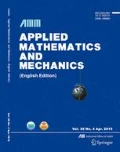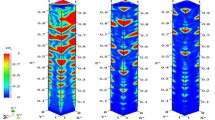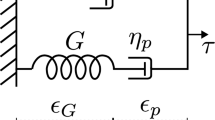Abstract
The paper concerns numerical analysis of pressure distribution of an oil film on the valve plate in the variable height gap of an axial piston pump. The analysis employs the finite element method. For determination of oil pressure variations in the gap, the Reynolds equation, commonly applied in the theory of lubrication, is applied. The equation is solved numerically with the use of self-developed program based on the finite element method. In order to obtain high accuracy of the results, an adaptive mesh refinement based on residual estimations of solution errors is applied. The calculation results are represented as dependent on the geometric and working parameters of the pump.
Similar content being viewed by others
References
Osiecki, A. Hydrostatic Machine Drive (in Polish), WNT (Scientific-Technical Publishing House) Warsaw (1998)
Rakowski, J. and Stryczek, S. Dynamic measurement of gap width in valve of a multi-piston axial pump (in Polish). Control and Hydraulic Drive 3, 7–9 (1981)
Stryczek, S. Hydrostatic Drive, Band 1 (in Polish), WNT (Scientific-Technical Publishing House), Warsaw (1995)
Jang, D. S. Loss Analysis in Axial Piston Units (in German), Ph D disstertation, RWTH Aachen (1997)
Pasynkow, R. M. and Poswianski, W. S. Numerical calculation of Reynolds equation taking into account variable fluid viscosity (in reference to valve plate) (in Russian). Machine Construction Review 9, 26–29 (1993)
Ivantysyn, J. and Ivantysynova, M. Hydrostatic Pumps and Motors, Akademia Books International, New Delhi (2001)
Zienkiewicz, O. and Morgan, K. Finite Elements and Approximation, John Wiley & Sons, New York (1983)
Zienkiewicz, O. C. and Taylor, R. L. The Finite Element Method, Butterworth-Heinemann, Oxford (2000)
Ainsworth, M. and Oden, J. A posteriori Error Estimation in Finite Element Analysis, John Wiley & Sons, New York (2000)
Stewart, J. R. and Hughes, T. J. R. A tutorial in elementary finite element error analysis: a systematic presentation of a priori and a posteriori error estimates. Computational Methods in Applied Mechanical Engineering 158, 1–22 (1998)
Johnson, C. and Hansbo, P. Adaptive finite element methods in computational mechanics. Computational Methods in Applied Mechanical Engineering 82, 143–181 (1992)
Nagorka, A. and Sczygiol, N. Applicability of incomplete explicit residual error estimates in adaptive finite element simulations of solidification. International Conference on Adaptive Modelling and Simulation (eds. Wiberg, N. E. and Diez, P.), Göteborg, Sweden (2003)
Adjerid, S., Flaherty, J. E., and Babuska, I. A posteriori error estimation for the finite element method-of-lines solution of parabolic problems. Mathematical Models and Methods in Applied Science 9(2), 261–286 (1999)
Kunze, T. and Brunner, H. Vibroacoustic and optical examination of cavitation in axial-piston machines (in German). Olhydraulik und Pneumatik 40(8), 542–546 (1996)
Author information
Authors and Affiliations
Corresponding author
Additional information
(Communicated by Xing-ming GUO)
Rights and permissions
About this article
Cite this article
Zloto, T., Nagorka, A. An efficient FEM for pressure analysis of oil film in a piston pump. Appl. Math. Mech.-Engl. Ed. 30, 49–61 (2009). https://doi.org/10.1007/s10483-009-0106-z
Received:
Revised:
Published:
Issue Date:
DOI: https://doi.org/10.1007/s10483-009-0106-z




